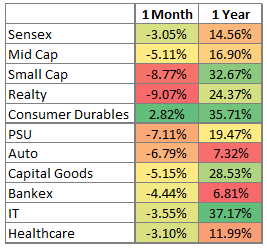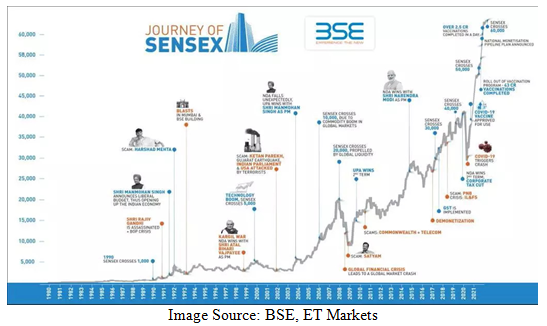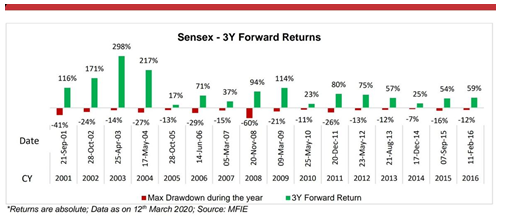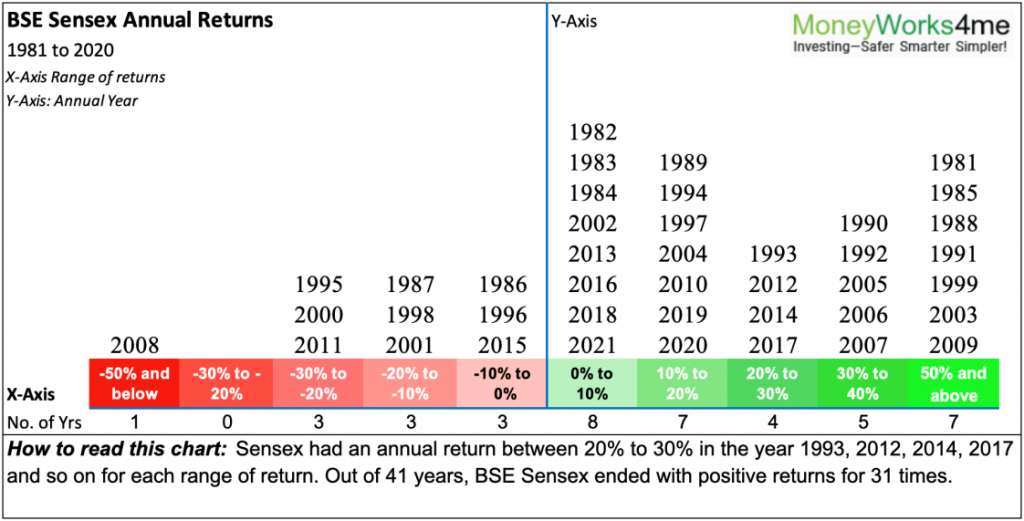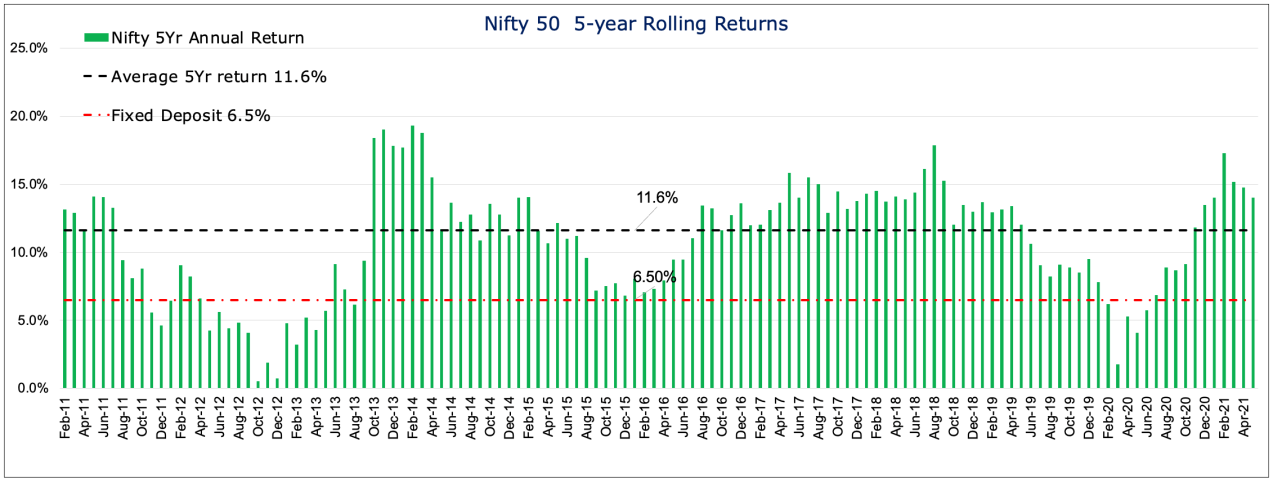This article covers the following:
For the year ending Feb’22, Sensex closed at ~56,247, up ~10% from last year. In the last 3 years, Sensex is up 56%; ~16% CAGR.
The last 1 year saw a massive shift in stock performance versus the prior 2 years where only Nifty stayed flat while the rest of the market saw correction. In the last 1 year, every segment of the market, small, mid, value, cyclical did better than Nifty.
In the past few years, especially in the last 2 years, low-interest rates globally and high investor participation in the global market have led to good gains in stocks.
Performance of PSU companies, Banking, and Auto companies was very good in the previous month. However, a bulk of those gains were wiped out owing to the war between Russia and Ukraine and the resultant fear of increased oil prices.
Nifty 50 index trades ~14% above its fair value while there are pockets of extreme overvaluation and undervaluation. Nifty – led by a concentrated portfolio of Top 10 stocks – is around ~12% higher than its fair price, while the same is not true for all stocks. (Nifty@MRP 14,920 Dec’21).
We are seeing a recovery in growth in the coming year so we may see an upward revision in our estimates. This can bring overvaluation down by ~5-10%.
As of date, the average upside of our coverage universe is likely to be closer to 10% CAGR over the next 5 years basis based on a current estimate. Similar to Nifty, the average upside of check
Today, we are looking at opportunities in banking and financial infrastructure, export-oriented capital goods, PSUs, and import substitute ideas. We continue to remain positive on existing companies that are delivering good growth. We are benefiting from early investments in building materials, industrials, and PSU companies. Optimistic outlook on real estate and increase in order flows has led to a rally in infra and infra-related stocks. We have added stocks in the industrials segment as we expect balance sheet strength to improve and cash flow growth will be better than past.
Stocks in IT Pharma and Chemicals have moved up ahead of their earnings growth, we have been reducing our allocation in the same. The same is true with few private companies in the power sector.
We look at companies that have good earning triggers over the next 2 years.
We are investing in companies;
- Coming out of sector consolidation/debt reduction, or
- Introducing new products, or
- Commissioning new capacities, or
- Executing orders in hand.
This gives certainty of growth rather than plain anticipation.
After the intent of the government to continue giving a boost to the CAPEX and investment in public infrastructure, we remain positive on the companies that would benefit from the Capex cycle. Infra, logistics, and industrial-related companies would be the key beneficiaries.
We are incrementally adding to banks. Banks are the key beneficiaries of credit cycle pick-up. As industrial activity improves, the working capital loans will be drawn from banks which will to credit growth. Retail loan growth has already picked in form of housing loans and discretionary purchases during the festive season.
We had a cautious stance on banks as we expected slippages in unsecured and SME loans. But as economic recovery happened faster thanks to vaccination, we are seeing stability in retail and corporate balance sheets. Large banks (AUM > 1,00,000 Cr) have made sufficient provisions as well as raised money to maintain a healthy capital adequacy ratio. With the fear of NPA being behind, they will start lending in areas that are growing well. SBI’s MD recently confirmed the companies in Infra, PSU, chemicals, and textiles are seeing good traction in asset growth backed by order book and demand both domestic and overseas.
Caution
We recommend avoiding stocks/sectors that have run up much ahead of their earnings growth over the last 3-4 years. We observe many small and mid-cap stocks have run ahead of valuation as non-institutional participation has led to excesses in few pockets. We reduced allocation to a few mid and small caps where prices have run up ahead of earnings growth.
We recommend treading cautiously in small-cap companies where sales figures are below 2019 levels but may optically look at high growth today on a low base of 2020. We recommend using FY19-20 sales as a base while evaluating growth or valuation. (Compute P/E ratio using EPS of 2019/20, Compute P/S ratio using Sales of 2019/20). We use 1-year forward Sales and EPS figures as we estimate the future growth of companies.
We have shifted focus to Core stocks (Large Cap, market leaders) that have strong future prospects which will provide better downside protection. However, one has to keep return expectations moderate as valuations are no longer cheap but in the fair value zone.
Dovish Monetary Policy and rising input prices due to Tense Geopolitical Situation
The Monetary Policy Committee has unanimously left policy rates unchanged and continued with the accommodative stance. The intention behind keeping the rates unchanged was that the durable recovery requires continued policy support. The rise in core inflation was a result of higher input prices (and not because of rising in demand). RBI refrained from announcing any steps to support the bond market and the same is visible with a reduction in the buying of bonds by RBI.
On the growth front, the projection for FY23 real GDP growth was at 7.8% noting downside risks from -global financial market volatility, elevated prices, especially crude oil, and persisting supply-side disruptions. However, the RBI remains optimistic of agricultural and rural demand, improved outlook for contact-intensive sectors and urban demand, and FY23 union budget announcement on boosting public infrastructure through enhanced capital expenditure.
You can read our analysis on Union Budget FY23 here.
In all, the guidance continues to be dominated by growth concerns and a softer inflation trajectory, signaling limited scope for rate actions, at least, until the June policy.
Indian Economy
Q3FY22 corporate earnings were promising showing the signs of recovery, led by the sectors like Banking, Auto, IT, Metals & Telecom. Pharma and Consumer-facing companies showed softness. The rural facing companies gave a weaker demand outlook in the foregone quarter due to high inflation, coupled with the base effect of last year when the growth rate was high. Real estate continued to witness strong up move. Normalization of economic activities continued through the month of February.
Going ahead we are expecting an acceleration in demand due to i) pent-up demand, ii) an increase in Capex leading to job growth (especially in rural and smaller cities), and iii) an increase in salaries of IT employees.
Near-term risks can come from rising inflation. India still imports the bulk of its crude oil requirement and gas. Any rise in price will have to be passed on to the consumer. Other commodities like natural gas or coal have also spiked due to shortage issues across several countries. If this persists we may see risk to equity valuation. Corporates are highlighting the risks in cost structure as gross margins are getting squeezed. Companies are not taking price hikes in a hurry as it may impact volume growth.
However, if we keep aside the current valuation, we are optimistic about the Indian economy over the next 5 years. Even if we purchase shares at slightly higher prices, there is a good chance of earning healthy returns over the next 5 years. The Indian corporate sector is in the best position to gain pricing power and balance sheet strength. The majority of the sectors have seen consolidation. We are seeing this across sectors: Power, Telecom, Cement, Banks, NBFCs, Real Estate, building materials, Paper, pharma, capital goods, consumer durables, etc. This will give strong profitability for incumbents due to the high barrier to entry for the next few years.
The US market corrected ~13.5% from its peak in the last month. We have been warning our investors about the overvaluation in the US market and had advised them to reduce their positions. We would recommend adding position once we see some more correction.
The interest rates are expected to rise as Fed has hinted at tightening financial conditions to put an end to the 40-year high inflation in the US. Financial conditions have comparatively tightened off late yet very easily compared to the historical perspective.
Russia-Ukraine war
Currently, markets globally are in the grip of 4 forces that are causing markets to correct- Geopolitical tensions between Russia and Ukraine, Fed interest rate hikes, higher inflation, and rising crude oil prices.
Just to give you a perspective, in the last 30 years multiple such events, wars, incidents, crashes, and boom, bubble bursts, assassinations have caused panic among investors leading them to trim/exit in the worst times instead of staying invested at the right level of allocation to equity.
In spite of these events and market corrections, markets have maintained their long-term upward trajectory.
Let’s have a look at some data on how markets responded to corrections in the past.
*There is always some risk but every risk doesn’t materialize. It is important to keep an eye on risks but it may not require an action every time.
Aggressive Investor: “Few stocks are making big moves why are we investing cautiously or selectively?”
Our process of fundamental analysis, and valuation-driven long-term investment management has served us well across market cycles. We do not move in and out sectors chasing price momentum nor do we believe that no price is too high for good merchandise. We have seen many cycles to believe that many of these tricks have good and bad years. We will also have our hits and misses but on aggregate, we try to deliver more consistent and higher returns versus other investment options.
For long-term success we prefer caution over aggression, balanced versus bold, sustainable growth versus temporary.
“A principle is not a principle until it costs you something.” – William “Bill” Bernbach
On similar lines, “A process is not a process until it costs you something (or pinches you).”
Conservative Investor: “What if we are at the fag end of the bull market, time to sell?”
We have seen many recessions in past and saw stock market recoveries over a 2-3 year period. In the current scenario, we are past the recessionary period already, so any interim correction will be transitionary and may see a faster recovery versus the past.
Let’s take the worst period with the benefit of hindsight when Nifty peaked in Dec’07 and 3 years after that.
If we observe individual stocks, we can see that markets made high in Dec’07, went through correction of 50%, and recovered in Dec’10. During this period Nifty was flat but more than 40% of stocks earned positive returns. Out of 185 large and mid-cap stocks (BSE Group A), 78 were positive, and more than half earned >13% CAGR. Together these 78 stocks earned >17% CAGR.
Now, this was the worst-case scenario where the market had a stellar bull run in 4 years preceding 2007. Companies had added a lot of debt for expansion and valuations were expensive.
Today, we are past recession i.e. back to back GDP de-growth and most companies are in much better shape than in Dec’07 at low utilization, low debt, and upward trajectory in volume growth.
The above table shows that, if we can pick stocks carefully by avoiding ones that have run ahead of their growth and inferior quality, we increase our odds of making very good returns in a 3/5 year period.
If we do get interim correction, we can earn more as we get to add to stocks at cheaper valuations. On your own, you can set up an additional SIP during interim correction to improve returns. Odds are highly in favor of staying invested rather than exiting or delaying fresh addition as we can’t predict the right time to invest expect in hindsight.
If we look at past data, there was an 85% chance of beating FD return on 5 year period. If your time horizon is long-term (5 years+), the current valuation will matter less and near-term events become irrelevant. We do not find any merit in second-guessing what’s going to happen in the next 6 months-1 year.
This is the reason we recommend not to disturb the equity portion in your asset allocation. Changing your asset allocation will reduce long-term returns or missing out on the target corpus.
If you have decided to stay with 60% Equity and 40% debt, you can rebalance but do not deviate much from 60% in Equity. Use our Financial Planning tool to find your target corpus and required asset allocation/monthly saving.
We have diversified our stocks portfolio, we have diversified assets and we have a long-term horizon. Together this takes care of all potential risks in investing.
MoneyWorks4me Outlook:
How to Make Informed Stock-Investing Decisions:
Need help on Investing? And more….Puchho Befikar
Why MoneyWorks4me | Call: 020 6725 8333 | WhatsApp: 8055769463



